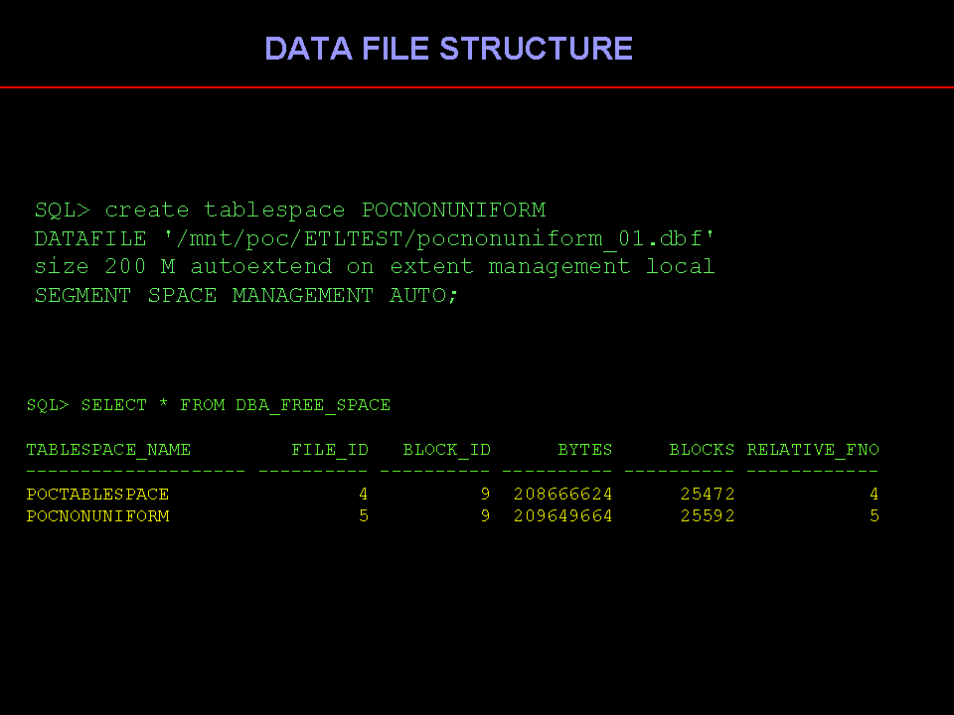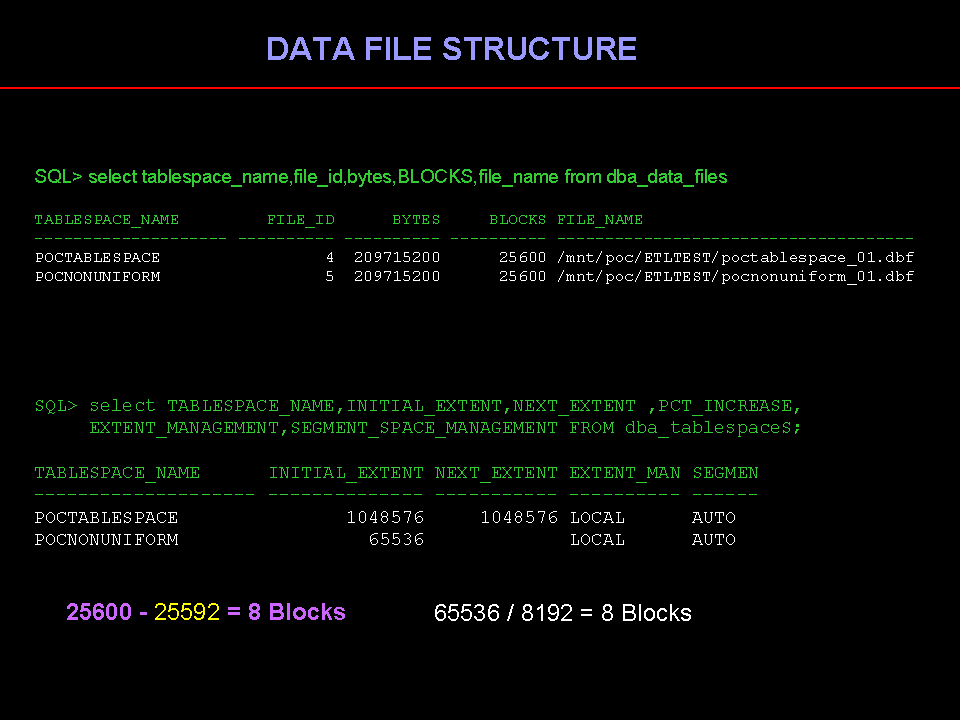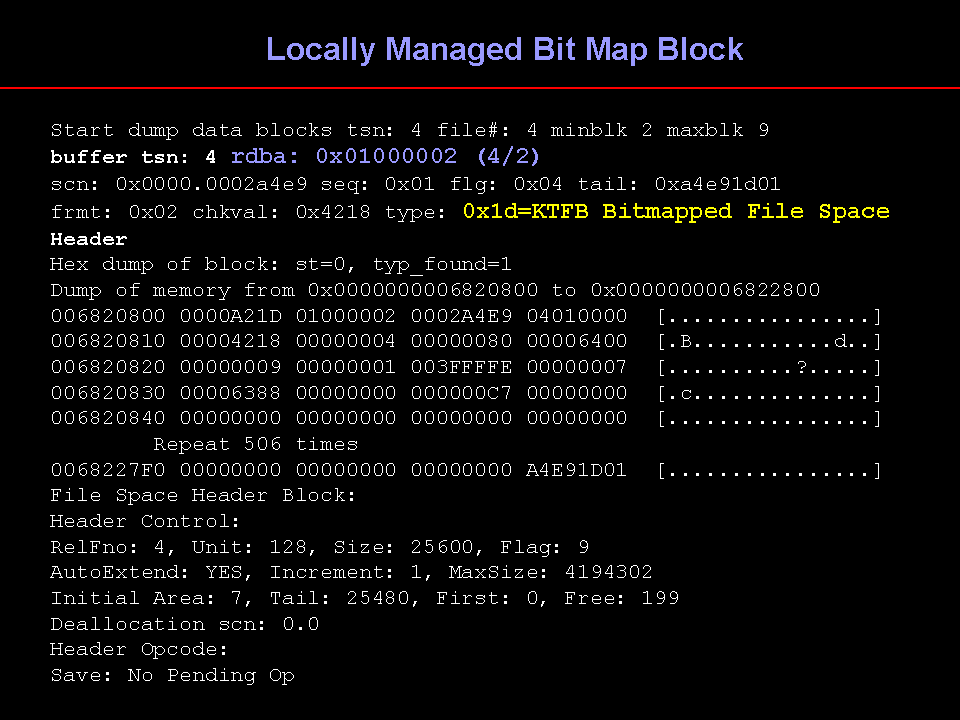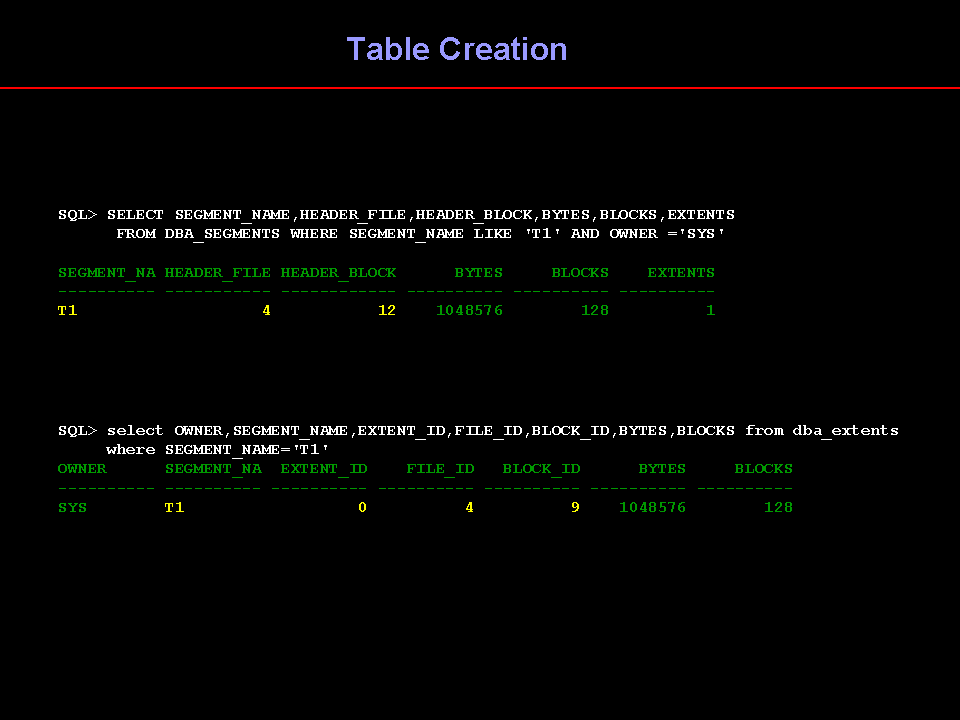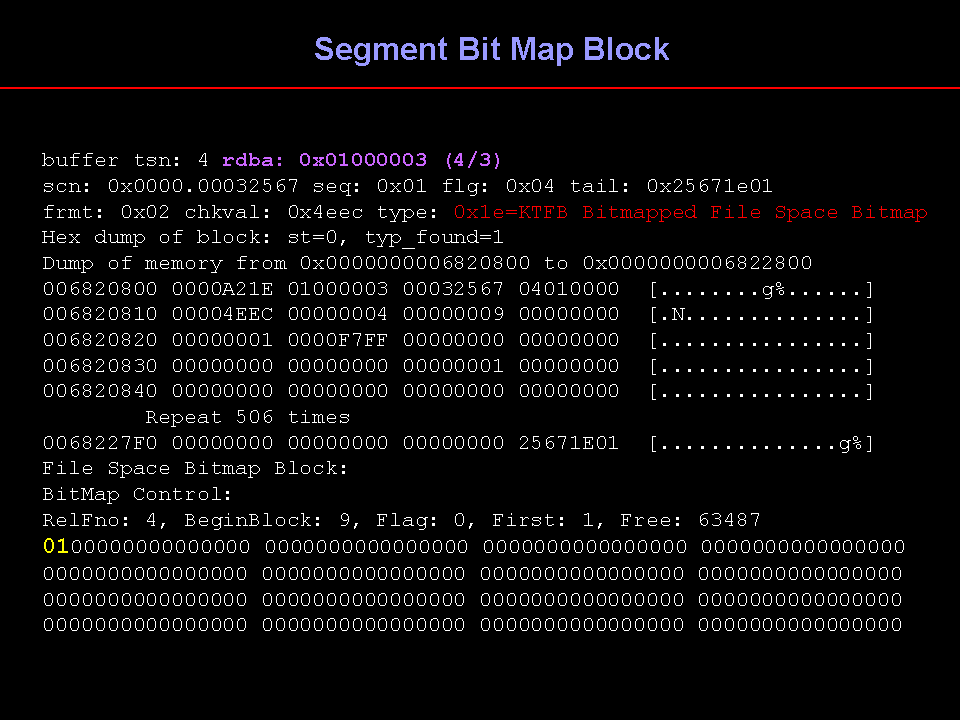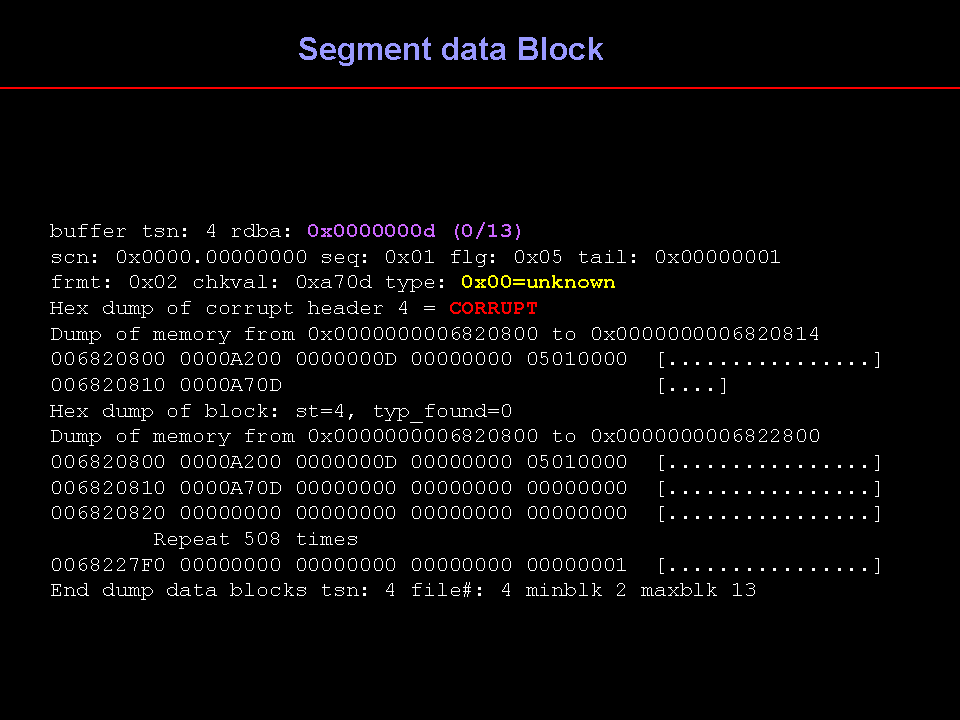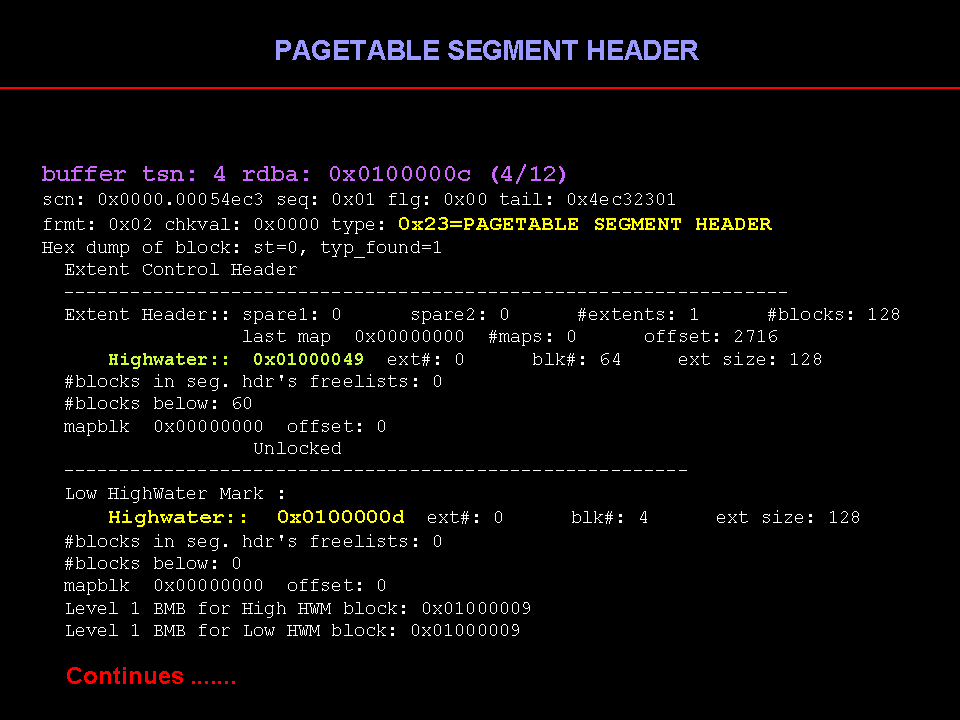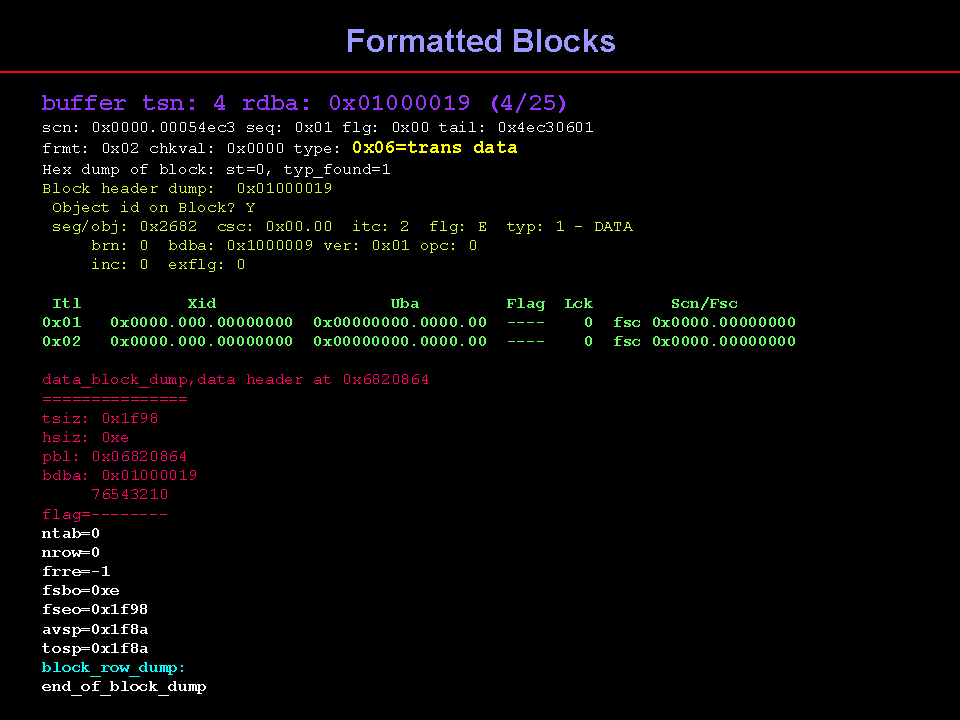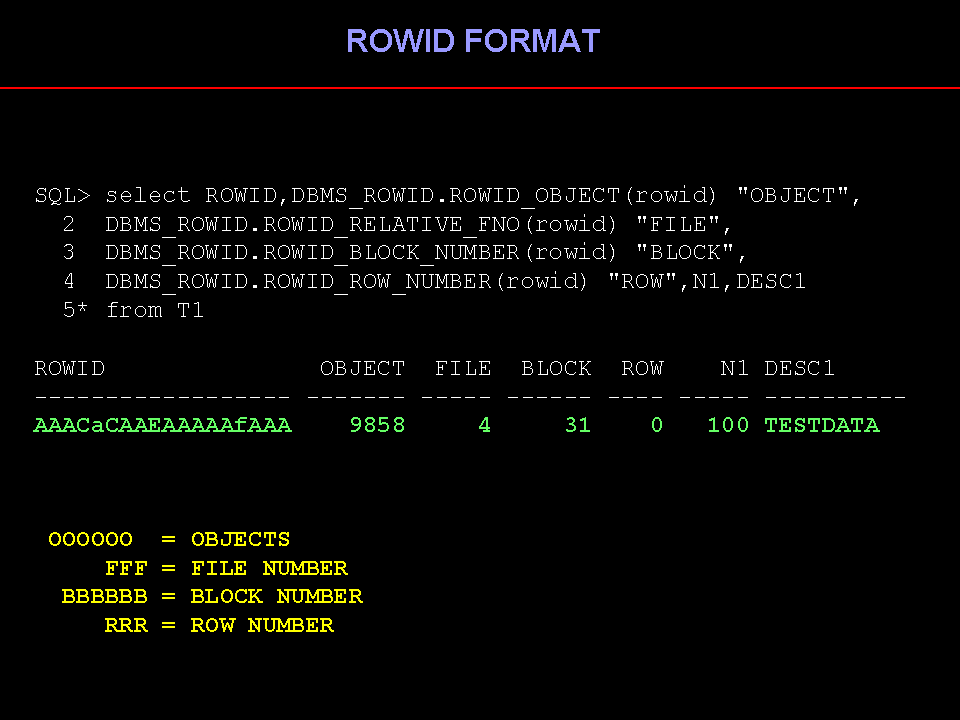Caution: Below example only for education purpose. It should not be used any real production environment
1. Create tablespace
CREATE TABLESPACE deleterow DATAFILE ‘/mnt/poc/ETLTEST/deleterow.dbf’ SIZE 5M SEGMENT SPACE MANAGEMENT AUTO;
2. SQL> SELECT TABLESPACE_NAME,FILE_ID,BYTES,BLOCKS,FILE_NAME FROM DBA_DATA_FILES;
TABLESPACE_NAME FILE_ID BYTES BLOCKS FILE_NAME
--------------- ---------- ---------- ---------- ---------------------------------
DELETEROW 9 5242880 640 /mnt/poc/ETLTEST/deleterow.dbf
3.SQL> SELECT * FROM DBA_FREE_SPACE;
TABLESPACE_NAME FILE_ID BLOCK_ID BYTES BLOCKS RELATIVE_FNO
--------------- ---------- ---------- ---------- ---------- ------------
DELETEROW 9 9 5177344 632 9
4. SQL> CREATE TABLE T10 (N1 number, desc1 varchar2(10)) TABLESPACE DELETEROW;
Table created.
5. SQL> SELECT OBJECT_NAME,OBJECT_ID,OBJECT_TYPE FROM DBA_OBJECTS
WHERE OBJECT_NAME='T10' AND OWNER='SYS'
OBJECT_NAM OBJECT_ID OBJECT_TYPE
---------- ---------- ------------
T10 10576 TABLE
6. SQL> SELECT * FROM DBA_FREE_SPACE;
TABLESPACE_NAME FILE_ID BLOCK_ID BYTES BLOCKS RELATIVE_FNO
--------------- ---------- ---------- ---------- ---------- ------------
DELETEROW 9 17 5111808 624 9
7.SQL> SELECT SEGMENT_NAME,HEADER_FILE,HEADER_BLOCK,BYTES,BLOCKS,EXTENTS
FROM DBA_SEGMENTS WHERE SEGMENT_NAME LIKE 'T10' AND OWNER ='SYS'
/
SEGMENT_NA HEADER_FILE HEADER_BLOCK BYTES BLOCKS EXTENTS
---------- ----------- ------------ ---------- ---------- ----------
T10 9 11 65536 8 1
8.SQL> select * from t10;
no rows selected
9.SQL> insert into t10 values (100,'TESTDATA1');
1 row created.
SQL> insert into t10 values (200,'TESTDATA2');
1 row created.
SQL> insert into t10 values (300,'TESTDATA2');
1 row created.
SQL> insert into t10 values (400,'TESTDATA4');
1 row created.
SQL> insert into t10 values (500,'TESTDATA5');
1 row created.
SQL> COMMIT;
Commit complete.
10. SQL>
1 select ROWID,DBMS_ROWID.ROWID_OBJECT(rowid) "OBJECT",
2 DBMS_ROWID.ROWID_RELATIVE_FNO(rowid) "FILE",
3 DBMS_ROWID.ROWID_BLOCK_NUMBER(rowid) "BLOCK",
4 DBMS_ROWID.ROWID_ROW_NUMBER(rowid) "ROW",N1,DESC1
5* from T10
ROWID OBJECT FILE BLOCK ROW N1 DESC1
------------------ ---------- ---------- ---------- ---------- ---------- ----------
AAAClQAAJAAAAAPAAA 10576 9 15 0 100 TESTDATA1
AAAClQAAJAAAAAPAAB 10576 9 15 1 200 TESTDATA2
AAAClQAAJAAAAAPAAC 10576 9 15 2 300 TESTDATA2
AAAClQAAJAAAAAPAAD 10576 9 15 3 400 TESTDATA4
AAAClQAAJAAAAAPAAE 10576 9 15 4 500 TESTDATA5
11. SELECT N1,DUMP(N1,16) DUMP_N1,DESC1,DUMP(DESC1,16) DUMP_DESC1 FROM T10
N1 DUMP_N1 DESC1 DUMP_DESC1
----- -------------------- ------------ ----------------------------------------
100 Typ=2 Len=2: c2,2 TESTDATA1 Typ=1 Len=9: 54,45,53,54,44,41,54,41,31
200 Typ=2 Len=2: c2,3 TESTDATA2 Typ=1 Len=9: 54,45,53,54,44,41,54,41,32
300 Typ=2 Len=2: c2,4 TESTDATA2 Typ=1 Len=9: 54,45,53,54,44,41,54,41,32
400 Typ=2 Len=2: c2,5 TESTDATA4 Typ=1 Len=9: 54,45,53,54,44,41,54,41,34
500 Typ=2 Len=2: c2,6 TESTDATA5 Typ=1 Len=9: 54,45,53,54,44,41,54,41,35
12. dump
buffer tsn: 9 rdba: 0x0240000f (9/15)
scn: 0x0000.00090d89 seq: 0x02 flg: 0x02 tail: 0x0d890602
frmt: 0x02 chkval: 0x0000 type: 0x06=trans data
Hex dump of block: st=0, typ_found=1
Block header dump: 0x0240000f
Object id on Block? Y
seg/obj: 0x2950 csc: 0x00.8ff2e itc: 2 flg: E typ: 1 - DATA
brn: 0 bdba: 0x2400009 ver: 0x01 opc: 0
inc: 0 exflg: 0
Itl Xid Uba Flag Lck Scn/Fsc
0x01 0x0009.02d.000000a5 0x00800659.005b.0f C--- 0 scn 0x0000.0008fece
0x02 0x0000.000.00000000 0x00000000.0000.00 ---- 0 fsc 0x0000.00000000
data_block_dump,data header at 0x6820864
===============
tsiz: 0x1f98
hsiz: 0x1c
pbl: 0x06820864
bdba: 0x0240000f
76543210
flag=--------
ntab=1
nrow=5
frre=-1
fsbo=0x1c
fseo=0x1f48
avsp=0x1f2c
tosp=0x1f2c
0xe:pti[0] nrow=5 offs=0
0x12:pri[0] offs=0x1f88
0x14:pri[1] offs=0x1f78
0x16:pri[2] offs=0x1f68
0x18:pri[3] offs=0x1f58
0x1a:pri[4] offs=0x1f48
block_row_dump:
tab 0, row 0, @0x1f88
tl: 16 fb: --H-FL-- lb: 0x0 cc: 2
col 0: [ 2] c2 02
col 1: [ 9] 54 45 53 54 44 41 54 41 31
tab 0, row 1, @0x1f78
tl: 16 fb: --H-FL-- lb: 0x0 cc: 2
col 0: [ 2] c2 03
col 1: [ 9] 54 45 53 54 44 41 54 41 32
tab 0, row 2, @0x1f68
tl: 16 fb: --H-FL-- lb: 0x0 cc: 2
col 0: [ 2] c2 04
col 1: [ 9] 54 45 53 54 44 41 54 41 32
tab 0, row 3, @0x1f58
tl: 16 fb: --H-FL-- lb: 0x0 cc: 2
col 0: [ 2] c2 05
col 1: [ 9] 54 45 53 54 44 41 54 41 34
tab 0, row 4, @0x1f48
tl: 16 fb: --H-FL-- lb: 0x0 cc: 2
col 0: [ 2] c2 06
col 1: [ 9] 54 45 53 54 44 41 54 41 35
end_of_block_dump
13.02c11302 c1080600 4002a100 060cc000 l .Á..Á...@.¡...À.
10001800 10003100 02000100 03000200 l ......1.........
fd000000 fb000000 00000000 c3028000 l ý...û.......Ã...
0b010e00 00009e00 02010000 2c000202 l ............,...
c2060954 45535444 41544135 2c000202 l Â..TESTDATA5,...
c2050954 45535444 41544134 2c000202 l Â..TESTDATA4,...
c2040954 45535444 41544132 2c000202 l Â..TESTDATA2,...
c2030954 45535444 41544132 2c000202 l Â..TESTDATA2,...
c2020954 45535444 41544131 01062eff l Â..TESTDATA1....
14.SQL> select * from t10;
N1 DESC1
---------- ----------
100 TESTDATA1
200 TESTDATA2
300 TESTDATA2
400 TESTDATA4
500 TESTDATA5
15. SQL> delete t10 where n1=300;
1 row deleted.
SQL> select * from t10;
N1 DESC1
---------- ----------
100 TESTDATA1
200 TESTDATA2
400 TESTDATA4
500 TESTDATA5
16.
buffer tsn: 9 rdba: 0x0240000f (9/15)
scn: 0x0000.00090d89 seq: 0x02 flg: 0x02 tail: 0x0d890602
frmt: 0x02 chkval: 0x0000 type: 0x06=trans data
Hex dump of block: st=0, typ_found=1
Block header dump: 0x0240000f
Object id on Block? Y
seg/obj: 0x2950 csc: 0x00.8ff2e itc: 2 flg: E typ: 1 – DATA
brn: 0 bdba: 0x2400009 ver: 0x01 opc: 0
inc: 0 exflg: 0
Itl Xid Uba Flag Lck Scn/Fsc
0x01 0x0009.02d.000000a5 0x00800659.005b.0f C— 0 scn 0x0000.0008fece
0x02 0x000a.020.0000014e 0x008005f9.0073.2a –U- 1 fsc 0x000e.00090d89
data_block_dump,data header at 0x6820864
data_block_dump,data header at 0x6820864
===============
tsiz: 0x1f98
hsiz: 0x1c
pbl: 0x06820864
bdba: 0x0240000f
76543210
flag=——–
ntab=1
nrow=5
frre=-1
fsbo=0x1c
fseo=0x1f48
avsp=0x1f2c
tosp=0x1f3c
0xe:pti[0] nrow=5 offs=0
0x12:pri[0] offs=0x1f88
0x14:pri[1] offs=0x1f78
0x16:pri[2] offs=0x1f68
0x18:pri[3] offs=0x1f58
0x1a:pri[4] offs=0x1f48
block_row_dump:
tab 0, row 0, @0x1f88
tl: 16 fb: –H-FL– lb: 0x0 cc: 2
col 0: [ 2] c2 02
col 1: [ 9] 54 45 53 54 44 41 54 41 31
tab 0, row 1, @0x1f78
tl: 16 fb: –H-FL– lb: 0x0 cc: 2
col 0: [ 2] c2 03
col 1: [ 9] 54 45 53 54 44 41 54 41 32
tab 0, row 2, @0x1f68
tl: 2 fb: –HDFL– lb: 0x2
tab 0, row 3, @0x1f58
tl: 16 fb: –H-FL– lb: 0x0 cc: 2
col 0: [ 2] c2 05
col 1: [ 9] 54 45 53 54 44 41 54 41 34
tab 0, row 4, @0x1f48
tl: 16 fb: –H-FL– lb: 0x0 cc: 2
col 0: [ 2] c2 06
col 1: [ 9] 54 45 53 54 44 41 54 41 35
end_of_block_dump
17. hex dump
10001800 10003100 02000100 03000200 l ......1.........
fd000000 fb000000 00000000 c3028000 l ý...û.......Ã...
0b010e00 00009e00 02010000 2c000202 l ............,...
c2060954 45535444 41544135 2c000202 l Â..TESTDATA5,...
c2050954 45535444 41544134 3c020202 l Â..TESTDATA4<...
c2040954 45535444 41544132 2c000202 l Â..TESTDATA2,...
c2030954 45535444 41544132 2c000202 l Â..TESTDATA2,...
c2020954 45535444 41544131 0206890d l Â..TESTDATA1....
18. using hex editor , change the 0ffset 8140 to 2c
tl: 2 fb: --HDFL-- lb: 0x2
oracle row header flag value changed 2c to 3c while deleting the row (–HDFL)
Flag byte
– – – – – – – Continues data piece from previous row
H: Head of row piece
K: Cluster key
C: Cluster table member
D: Deleted row
F: First data piece,
L: Last data piece
P: First column continues from previous row
N: Last column continues
19
buffer tsn: 9 rdba: 0x0240000f (9/15)
scn: 0x0000.00090d89 seq: 0x02 flg: 0x06 tail: 0x0d890602
frmt: 0x02 chkval: 0xe269 type: 0x06=trans data
Hex dump of block: st=0, typ_found=1
006822770 0213C102 000608C1 00A10240 00C00C06 [........@.......]
006822780 00180010 00310010 00010002 00020003 [......1.........]
006822790 000000FD 000000FB 00000000 008002C3 [................]
0068227A0 000E010B 009E0000 00000102 0202002C [............,...]
0068227B0 540906C2 44545345 35415441 0202002C [...TESTDATA5,...]
0068227C0 540905C2 44545345 34415441 0202022C [...TESTDATA4,...]
0068227D0 540904C2 44545345 32415441 0202002C [...TESTDATA2,...]
0068227E0 540903C2 44545345 32415441 0202002C [...TESTDATA2,...]
0068227F0 540902C2 44545345 31415441 0D890602 [...TESTDATA1....]
Block header dump: 0x0240000f
Object id on Block? Y
seg/obj: 0x2950 csc: 0x00.8ff2e itc: 2 flg: E typ: 1 – DATA
brn: 0 bdba: 0x2400009 ver: 0x01 opc: 0
inc: 0 exflg: 0
Itl Xid Uba Flag Lck Scn/Fsc
0x01 0x0009.02d.000000a5 0x00800659.005b.0f C— 0 scn 0x0000.0008fece
0x02 0x000a.020.0000014e 0x008005f9.0073.2a –U- 1 fsc 0x000e.00090d89
data_block_dump,data header at 0x6820864
===============
tsiz: 0x1f98
hsiz: 0x1c
pbl: 0x06820864
bdba: 0x0240000f
76543210
flag=——–
ntab=1
nrow=5
frre=-1
fsbo=0x1c
fseo=0x1f48
avsp=0x1f2c
tosp=0x1f3c
0xe:pti[0] nrow=5 offs=0
0x12:pri[0] offs=0x1f88
0x14:pri[1] offs=0x1f78
0x16:pri[2] offs=0x1f68
0x18:pri[3] offs=0x1f58
0x1a:pri[4] offs=0x1f48
block_row_dump:
tab 0, row 0, @0x1f88
tl: 16 fb: –H-FL– lb: 0x0 cc: 2
col 0: [ 2] c2 02
col 1: [ 9] 54 45 53 54 44 41 54 41 31
tab 0, row 1, @0x1f78
tl: 16 fb: –H-FL– lb: 0x0 cc: 2
col 0: [ 2] c2 03
col 1: [ 9] 54 45 53 54 44 41 54 41 32
tab 0, row 2, @0x1f68
tl: 16 fb: –H-FL– lb: 0x2 cc: 2
col 0: [ 2] c2 04
col 1: [ 9] 54 45 53 54 44 41 54 41 32
tab 0, row 3, @0x1f58
tl: 16 fb: –H-FL– lb: 0x0 cc: 2
col 0: [ 2] c2 05
col 1: [ 9] 54 45 53 54 44 41 54 41 34
tab 0, row 4, @0x1f48
tl: 16 fb: –H-FL– lb: 0x0 cc: 2
col 0: [ 2] c2 06
col 1: [ 9] 54 45 53 54 44 41 54 41 35
end_of_block_dump
20.
fd000000 fb000000 00000000 c3028000 l ý…û…….Ã…
0b010e00 00009e00 02010000 2c000202 l …………,…
c2060954 45535444 41544135 2c000202 l Â..TESTDATA5,…
c2050954 45535444 41544134 2c020202 l Â..TESTDATA4,…
c2040954 45535444 41544132 2c000202 l Â..TESTDATA2,…
c2030954 45535444 41544132 2c000202 l Â..TESTDATA2,…
c2020954 45535444 41544131 0206890d l Â..TESTDATA1….
21.
SQL> l
1 SELECT ROWID,DBMS_ROWID.ROWID_OBJECT(ROWID) “OBJECT”,
2 DBMS_ROWID.ROWID_RELATIVE_FNO(ROWID) “FILE”,
3 DBMS_ROWID.ROWID_BLOCK_NUMBER(ROWID) “BLOCK”,
4 DBMS_ROWID.ROWID_ROW_NUMBER(ROWID) “ROW”,N1,DESC1
5* FROM T10
SQL> /
ROWID OBJECT FILE BLOCK ROW N1 DESC1
—————— ———- ———- ———- ———- ———- ———-
AAAClQAAJAAAAAPAAA 10576 9 15 0 100 TESTDATA1
AAAClQAAJAAAAAPAAB 10576 9 15 1 200 TESTDATA2
AAAClQAAJAAAAAPAAC 10576 9 15 2 300 TESTDATA2
AAAClQAAJAAAAAPAAD 10576 9 15 3 400 TESTDATA4
AAAClQAAJAAAAAPAAE 10576 9 15 4 500 TESTDATA5
SQL> select * from t10;
N1 DESC1
———- ———-
100 TESTDATA1
200 TESTDATA2
300 TESTDATA2
400 TESTDATA4
500 TESTDATA5





